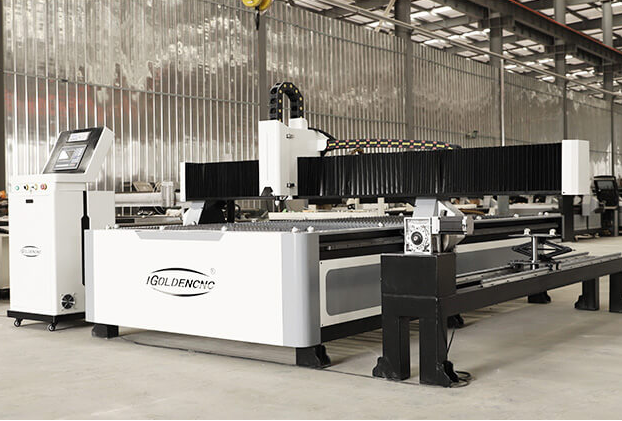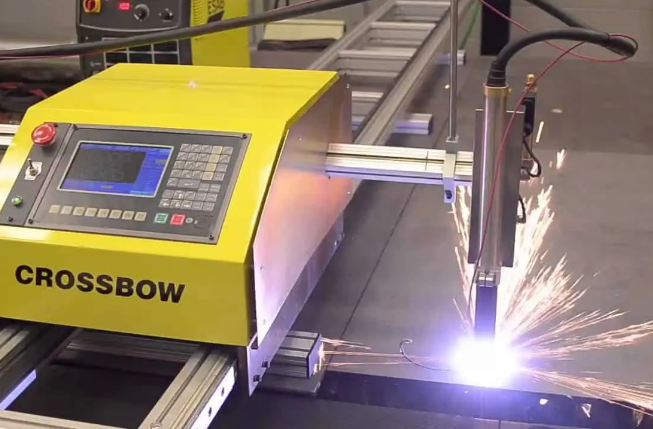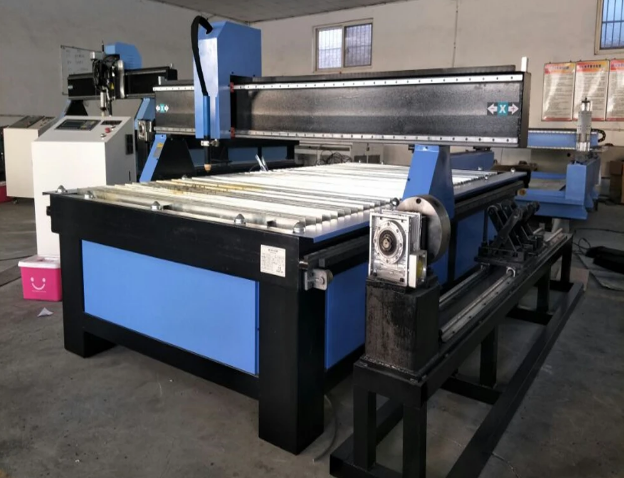Types of CNC Plasma Cutters
CNC plasma cutters, a pivotal tool in metalworking, come in various forms to meet diverse industrial and artistic needs. Understanding the differences between these types helps users select the right machine for their specific projects.
Portable vs. Stationary Models
Portable CNC Plasma Cutters
These models offer remarkable flexibility and mobility, making them ideal for on-site jobs or small workshops. Typically, they weigh less, are easier to transport, and can handle a range of materials with precision. However, their size might limit the maximum cutting area.
Stationary CNC Plasma Cutters
Stationary models, designed for heavy-duty use, dominate in industrial settings. They excel in handling larger and thicker materials, offering extended power and cutting capabilities. These cutters often require a dedicated space due to their size and power requirements.

Standard vs. High Definition Cutters
Standard CNC Plasma Cutters
Standard cutters provide a cost-effective solution for general metal cutting tasks. They are widely used due to their affordability and suitability for a range of materials. Standard models typically operate at lower speeds and might not offer the finest cut quality.
High Definition CNC Plasma Cutters
High definition cutters stand out for their superior cut quality and precision. They use advanced technology to achieve smoother edges and finer details, making them a preferred choice for intricate designs. While they offer higher efficiency, the cost can be significantly greater than standard models.
In terms of specifications, CNC plasma cutters vary widely. Portable models might have a power range of 15-30 amps, suitable for cutting materials up to ½ inch thick. In contrast, stationary, high-definition models can operate at over 80 amps, cutting materials up to 2 inches thick. The lifespan of these machines depends on their build quality and maintenance, with well-maintained units lasting over a decade. Speed is another critical factor, with some high-end models reaching cutting speeds up to 500 inches per minute.
When considering the cost, portable units can start from a few thousand dollars, making them accessible for small businesses and hobbyists. On the other hand, high-definition, stationary cutters can cost tens of thousands, reflecting their advanced capabilities and intended industrial use. Despite the higher upfront cost, these machines offer significant long-term value due to their efficiency and quality of output.
Factors Influencing the Cost of CNC Plasma Cutters
The cost of CNC plasma cutters is not a one-size-fits-all matter. Various factors play a crucial role in determining the price, making it essential for buyers to understand what drives these costs.
Size and Cutting Capacity
Size Matters
The physical size of a CNC plasma cutter directly impacts its price. Larger machines, capable of handling bigger materials, come with a heftier price tag. They often feature more robust construction and larger cutting beds, necessitating higher material and manufacturing costs.
Cutting Capacity: A Key Factor
Cutting capacity, referring to the thickness and type of material the machine can handle, also dictates the cost. Machines designed for thicker, tougher materials require more powerful, and consequently, more expensive components. For example, a machine capable of cutting 1-inch thick steel plate will cost more than one designed for ¼ inch plates, due to the need for higher power output and more durable components.
Advanced Features and Technology
Innovative Features Increase Value
CNC plasma cutters equipped with advanced features like automatic height control, faster cutting speeds, and improved precision command higher prices. These features not only enhance the machine’s capabilities but also increase its efficiency and lifespan.
Technology Plays a Crucial Role
The integration of cutting-edge technology, such as high-definition plasma systems, significantly affects the price. These technologies offer finer cuts, faster processing, and reduced waste, thus justifying their higher costs. For instance, a machine with a high-definition plasma system can be several times more expensive than a standard plasma cutter.
Power requirements also influence the cost. Machines with higher power ratings (measured in amps) can cut through thicker materials but require more electrical power, thus increasing operational costs. The efficiency of a machine, often reflected in its speed (measured in inches per minute) and precision, can offset these costs by reducing waste and increasing productivity.
To sum up, when evaluating the cost of a CNC plasma cutter, potential buyers should consider these factors. Understanding the balance between size, cutting capacity, advanced features, and technological integration is key to making a cost-effective decision. For a more detailed understanding of CNC plasma technology and its applications, one can refer to the Wikipedia page on CNC Plasma Cutting.
Comparing Prices of Popular Brands
When exploring the CNC plasma cutter market, it’s essential to compare prices across different brands. This comparison reveals a spectrum of options, from budget-friendly to premium models, each offering unique features and capabilities.
Budget-Friendly vs. Premium Brands
Budget-Friendly Brands Offer Accessibility
Budget-friendly CNC plasma cutters provide an entry point for hobbyists and small businesses. These models, while less expensive, often feature lower power outputs, typically ranging from 30 to 50 amps, suitable for thinner materials. The cost for such models usually falls between $1,000 and $5,000, offering basic functionalities without advanced technological integrations.
Premium Brands: Higher Cost, Higher Quality
Premium brands, on the other hand, cater to industrial needs with high precision and efficiency. These cutters often feature power outputs exceeding 80 amps, capable of handling thick materials with high precision. The price for premium models can range from $10,000 to over $30,000, reflecting their advanced features, such as automated control systems, faster cutting speeds, and longer lifespans.

Market Trends and Price Range
Evolving Market Trends Influence Costs
Market trends in CNC plasma cutting technology significantly affect the pricing landscape. With advancements in technology, even budget models are now offering features once exclusive to high-end machines, like improved cutting speeds and better material handling.
Price Range Across the Market
The price range in the CNC plasma cutter market is broad, influenced by factors like brand reputation, machine size, and technological advancements. While some small, portable machines are available under $1,000, large, industrial-grade machines with state-of-the-art technology can cost upwards of $50,000.
For those interested in the technical specifics and historical development of CNC plasma cutting technology, a visit to Wikipedia’s page on Plasma Cutting can provide valuable insights. This understanding can guide buyers in making an informed decision, balancing cost with the machine’s capabilities and intended use.
Operational Costs and Maintenance
Understanding the operational costs and maintenance requirements of CNC plasma cutters is crucial for long-term budgeting and efficient operation. These aspects significantly influence the total cost of ownership beyond the initial purchase.
Energy Consumption and Efficiency
Energy Consumption Varies by Model
Energy consumption is a key factor in operational costs. Smaller, portable models typically have lower power requirements, often around 5-10 kW, making them more economical for light use. In contrast, larger, industrial-grade machines can consume 20 kW or more, leading to higher electricity bills.
Efficiency Reduces Long-Term Costs
Efficiency in CNC plasma cutters translates to faster cutting speeds and less energy waste. Advanced models with higher efficiency ratings can offset their higher power consumption by completing jobs more quickly, thus reducing the overall energy used per project.
Maintenance and Replacement Parts
Regular Maintenance Ensures Longevity
Regular maintenance is essential for keeping CNC plasma cutters in top condition. This includes routine checks and cleaning, which help prevent breakdowns and extend the machine’s lifespan.

Replacement Parts: An Ongoing Expense
The cost of replacement parts varies depending on the brand and model. Consumables like electrodes, nozzles, and shields need regular replacement and can cost anywhere from a few dollars to several hundred dollars per set. High-end machines might use more expensive parts, but these often last longer, providing better value over time.
For those seeking to delve deeper into the intricacies of plasma cutting, including its operational aspects, Wikipedia’s article on Plasma Cutting offers comprehensive insights. It is important for users to consider these operational and maintenance costs when selecting a CNC plasma cutter, as they play a significant role in the total cost of ownership and the machine’s efficiency over its lifetime.
Buying Guide for CNC Plasma Cutters
Selecting the right CNC plasma cutter involves navigating through various options and understanding key factors that contribute to the machine’s performance and suitability for specific needs.
New vs. Used Machines
New Machines: Latest Technology and Reliability
New CNC plasma cutters come with the latest technology, offering higher efficiency and precision. Prices for new machines vary widely, starting from around $1,000 for basic models to over $50,000 for advanced industrial machines. Buyers get the advantage of full manufacturer warranties and the assurance of unused, pristine condition.
Used Machines: Cost-Effective but Riskier
Opting for a used CNC plasma cutter can be cost-effective, with prices significantly lower than new models. However, buyers should carefully assess the machine’s condition, checking for wear and tear, and ensuring it meets their power and size requirements. Used machines often come without warranties, posing a risk of unforeseen maintenance costs.
Warranties and After-Sales Support
Warranties Offer Peace of Mind
Warranties are crucial for protecting your investment. New machines typically come with a manufacturer’s warranty, which can range from 1 to 5 years, covering defects and certain maintenance aspects. Buyers should thoroughly understand warranty terms, as they can vary greatly between brands and models.
After-Sales Support: Essential for Longevity
Quality after-sales support can significantly extend a machine’s lifespan and ensure continuous operation. This includes access to technical support, replacement parts, and maintenance services. Brands known for good after-sales support often command higher prices but offer better long-term value.
For more detailed information on CNC plasma cutting, including its applications and technical specifications, interested individuals can explore Wikipedia’s Plasma Cutting page. This guide will help buyers make informed decisions, balancing their budget with the machine’s features, reliability, and the support they can expect after the purchase.

Additional Accessories and Software
Selecting the right accessories and software is crucial for maximizing the performance and capabilities of CNC plasma cutters. These elements enhance efficiency, precision, and the overall user experience.
Software Options and Upgrades
Software: The Brain of CNC Plasma Cutting
Software options for CNC plasma cutters range from basic to advanced, influencing both the machine’s capabilities and the price. Basic software might cost a few hundred dollars, sufficient for straightforward cutting tasks. In contrast, advanced software, which can cost several thousand dollars, offers enhanced features like complex design capabilities and improved cutting optimization.
Upgrades Enhance Machine Capabilities
Software upgrades play a key role in keeping a CNC plasma cutter up-to-date. They can introduce new features, improve efficiency, and even extend the machine’s lifespan. Upgrades vary in price, but investing in them can significantly enhance the machine’s functionality over time.
Essential Accessories and Add-ons
Accessories Improve Functionality and Safety
Essential accessories for CNC plasma cutters include items like cutting tables, ventilation systems, and safety gear. A good quality cutting table can cost anywhere from $1,000 to $5,000, depending on size and features. Ventilation systems, crucial for safety and compliance, can add several thousand dollars to the setup cost.
Add-ons Offer Customization and Efficiency
Additional add-ons like torch height controllers and extended warranty plans provide opportunities for customization and efficiency improvement. Torch height controllers, for example, can cost between $200 and $1,000, offering more precise control and better cut quality.
For those interested in exploring the full range of CNC plasma cutter technologies and accessories, Wikipedia’s Plasma Cutting page provides valuable insights. When purchasing a CNC plasma cutter, considering these software and accessory options is vital. They not only impact the initial investment but also play a significant role in the machine’s operational efficiency and the quality of the output.
